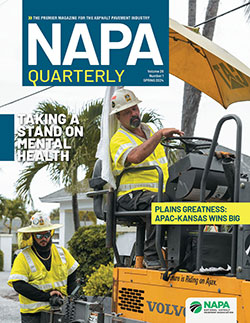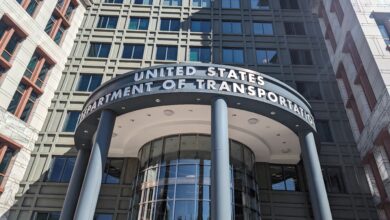NAPA Q&A with FHWA: Every Day Counts
NAPA Quarterly Editor Ty Johnson asked the Federal Highway Administration (FHWA) about the legacy of Every Day Counts as it moves into its second decade of innovations.
Learn about the beginning of Every Day Counts from Former FHWA Administrator Victor Mendez.
NAPA QUARTERLY: In what ways has EDC already met expectations in its first decade and how has that momentum translated into the latest round of innovations?
The Every Day Counts (EDC) program has made a significant positive impact in accelerating the deployment of innovations and in building a culture of innovation within the transportation community. Since its inception in 2010, each state has used 26 or more of the 57 innovations promoted through EDC, and some states have deployed more than 45. Many of these innovations have become mainstream practices across the country. As an added bonus in the EDC-7 cycle, FHWA published a multiyear Notice of Funding Opportunity for Accelerated Innovation Deployment (AID) Demonstration grants to provide incentive funds to eligible entities to accelerate the implementation and adoption of innovation in highway transportation and increased the federal share of the State Transportation Innovation Council (STIC) Incentive Program to $125,000 to support the costs of standardizing innovative practices in a state transportation agency or other public sector STIC.
Federal Highway Administration
NAPA Quarterly: The first slate of innovations promoted through Every Day Counts back in 2011 included warm-mix asphalt (WMA).
While WMA placement wasn’t unheard of in the United States, research performed in Missouri, Colorado, and at Yellowstone National Park as part of EDC 1 brought the practice into focus for many American producers and contractors and today it’s a major part of our nation’s road-building efforts, especially in cooler regions.
Has WMA permanently changed the way we build our infrastructure and how does it typify the rapid deployment goals and adoption of the larger EDC program?
Warm-mix asphalt has fundamentally changed the production of asphalt paving mixtures in the United States, in part because it can be used both as a compaction aid and a strategy to reduce asphalt plant fuel usage by lowering the production temperature by at least 10oF.
In 2010, FHWA made warm-mix asphalt part of its Every Day Counts initiative and has been working continuously since then with Industry, academia, and State DOTs to develop and implement WMA across the nation. This has resulted in development of additional WMA technologies such as plant foaming process and the rapid adoption of WMA by asphalt mixture producers. According to the NAPA, 44 state DOTs are currently using WMA technologies in their mixtures.
The EDC program demonstrates that leveraging existing technologies such as WMA and having a concentrated effort to deploy those technologies in cooperation with our FHWA stakeholders can lead to meaningful and rapid adoption.
FHWA
NAPA Quarterly: EDC innovations more familiar to motorists include countermeasures to reduce roadway departures, like those highlighted during EDC Round 5 in 2019.
The Transportation Research Board (TRB), through its National Cooperative Highway Research Program (NCHRP), identified the solutions state DOTs deployed to keep vehicles on the roadway, allow for safe recovery, and reduce the severity of crashes.

While usage of rumble strips, clear zones, and SafetyEdge are now commonplace, their widespread adoption has been made possible because of low costs and minor impacts to paving operations.
What are some of the challenges faced in identifying effective and easy-to-adopt innovations that ultimately ensure our infrastructure is built better, faster, smarter, and more equitably?
FHWA collaborates with state, local and industry partners, and the public to identify proven, market-ready but underutilized processes or technologies to promote in EDC. Those responding to the call for suggestions are asked to consider how the innovation or process contributes to:
- National Impact (How will it benefit the transportation system nationally?)
- Game-Changing (How is it transformative in making our transportation system adaptable, sustainable, resilient, equitable, and safer for all?)
- Urgency and Scale (How will it positively impact the environment, safety, congestion, freight movement, construction techniques, contracting methods, project costs, maintenance, preservation, or emergency response?)
- Readiness (whether there are supporting specifications, guidelines, or procedures available to support technology transfer and national deployment).
An example of this is an initiative launched under EDC-6 and continued in EDC-7 known as Strategic Workforce Development (SWD). A common theme that has been expressed by both DOTs and the contracting community is the difficulty in maintaining an adequately trained workforce. SWD advocates partnerships with industry partners like NAPA to help identify, train, place and retain individuals into highway construction careers.
FHWA
NAPA Quarterly: FHWA data show that about half of all invested pavement dollars go into overlays, meaning enhanced overlay performance can maximize that investment and create longer-lasting roads.
Targeted Overlay Pavement Solutions (TOPS) introduced in EDC-6 are opening roads sooner and giving extended life to high-maintenance roads and intersections.
Stone-matrix asphalt and polymer-modified or highly modified asphalt have emerged as difference makers for long-lived pavements in Maryland, Alabama, Utah, Florida, Georgia, New Jersey, Oklahoma, Tennessee, Virginia, and New York.
Reducing work zones and the amount of time roadside workers spend on site makes projects safer, too, but how does FHWA evaluate whether an innovation has been successful when there are regional factors to consider?
On-site construction activities can result in significant mobility and safety impacts to road users. The presence of work zones can also result in inconvenience to local business and community, noise, and environmental impacts. Minimizing the adverse impacts of work zones has become a higher priority especially since the inception of the FHWA Rule on Work Zone Safety and Mobility (23 CFR 630 Subpart J).
Work zone road user costs (WZ RUC) provide the economic basis for quantifying these adverse impacts, which can then be used for effective decision-making to improve work zone mobility and safety. FHWA published Work Zone Road User Costs – Concepts and Applications to provide practitioners with information on WZ RUC analysis concepts and their applications using case studies drawn from real world projects.
FHWA
NAPA Quarterly: The latest round of EDC makes the case for Environmental Product Declarations (EPDs) for Sustainable Project Delivery.
NAPA has sought to educate the industry on EPDs through its Emerald Eco-Label tool, but there is still resistance among some in the industry, even as these benchmarks help businesses conserve energy and save money.
What are some of the lessons from previous rounds of innovation that help inform the FHWA approach to this and other innovations that aren’t immediately adopted across the board?
The EDC-7 EPDs for Sustainable Project Delivery innovation continues FHWA’s momentum to promote innovative pavement and materials. Previous EDC initiatives successfully promoted pavement-related innovations such as warm-mix asphalt. pavement preservation (when, where, and how), high surface friction treatments, and targeted overlay pavement solutions. Since 2012, FHWA has promoted pavement technologies via the Accelerated Implementation and Deployment of Pavement Technologies (AID-PT) program.
At the center of all the EDC initiatives is stakeholder engagement and collaboration to identify and share lessons learned and develop solutions to implementation concerns as well as a deployment approach that utilizes several proven deployment strategies – including pilots, workshops, peer exchanges, and training – from these previous efforts.
One critical aspect of implementation is identifying a pathway for implementers to not only explore and pilot an innovation, but to also create one that incorporates the innovation into everyday business practices. In this respect, the EPDs for Sustainable Project Delivery innovation is well suited for success. The program builds upon years of Sustainable Pavements Program efforts such as the FHWA Climate Challenge and with the new FHWA Low Carbon Transportation Materials Program that was authorized in the IRA, implementers will have an opportunity to support and expand their use of EPDs.
FHWA
NAPA Quarterly: The Infrastructure Investment and Jobs Act (IIJA) and Inflation Reduction Act (IRA) have put a premium on EPDs, which can help demystify the environmental impacts of construction materials, and innovations like WMA that can help reduce the carbon footprint of asphalt production.
What do these priorities say about the future of roadbuilding and the role FHWA and EDC will continue to play in creating sustainable infrastructure?
These priorities demonstrate that FHWA and the surface transportation community are serious about, and have been given a mandate by the public, to address our changing climate and prepare for future conditions. Sustainability thinking that designs, constructs, and maintains transportation infrastructure systems which minimize environmental impacts while maximizing economic benefits and ensuring equitable social outcomes has to be our way of doing business.
EPDs are one innovation that can provide critical information to inform sustainable decision-making throughout the project delivery process. FHWA’s leadership to advance the deployment of innovations such as EPDs and WMA and ability to engage stakeholders from various perspectives and expertise through programs like EDC will be key to the success of the entire surface transportation community.
FHWA




.png)
%20Verified.jpg)
